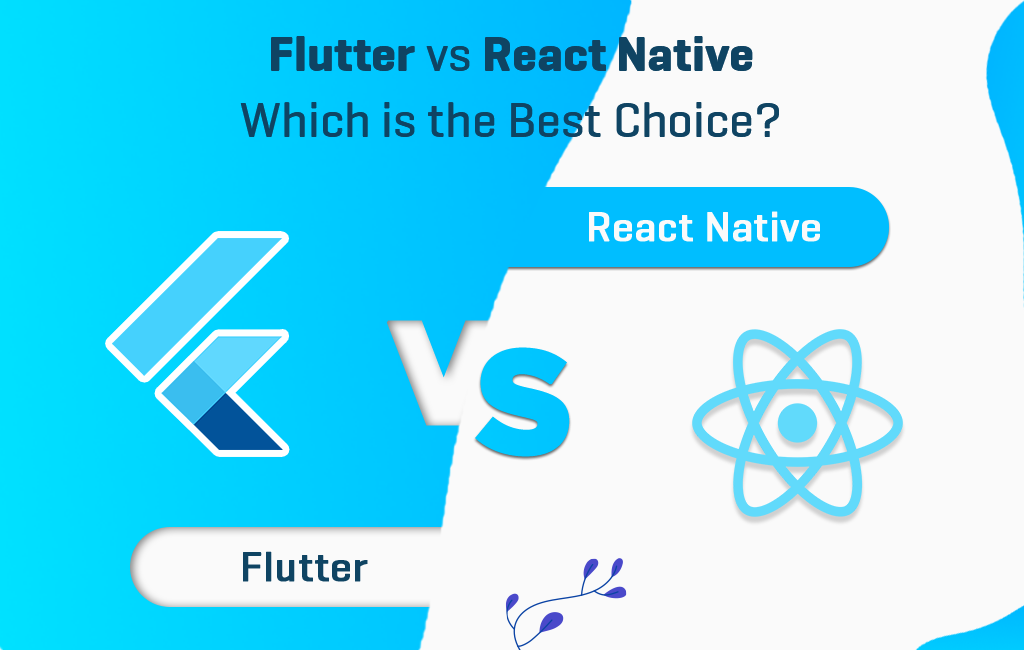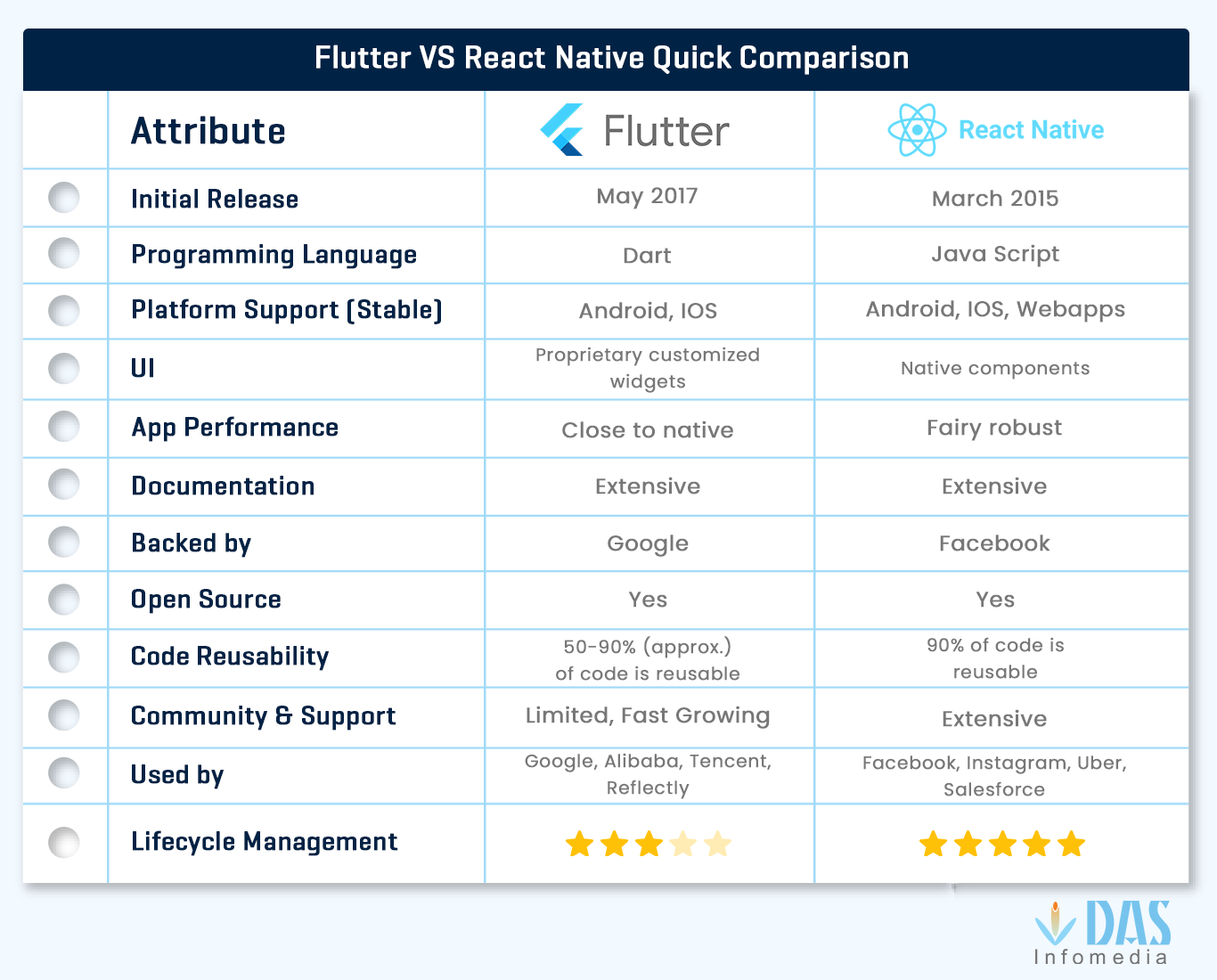Whenever any Native app is developed for Android, It will not work for iOS and vice-versa. Both these platforms have different technologies for building apps for them individually. Apps for Android can be developed with the help of Android Studio or Kotlin, whereas in iOS, it needs the sound knowledge of X Code or Swift. The developer has to know about all of these technologies. However there are few hybrid app frameworks available online like Flutter and React Native which is considered as the most reliable and feasible frameworks.

React Native Development was built and supported by social media company Facebook in 2015. It has easy access to the native UI components, and the code can be used again and again. A hot reload feature is available together with access to high-quality third-party libraries. Flutter was first launched by Google itself. It is an open-source technology. Flutter includes a strong ecosystem and gives maximum customization. A hot reload feature is also available in a flutter with faster code compilation.
Architecture:
Let’s try to understand the technical architecture which is required while we analyses the Flutter vs React Native comparison.
- React Native: React Native uses the JavaScript Bridge, which is the JavaScript runtime environment. This provides a platform to communicate with the native modules. JSON messages are generally used in communication between these two sides. This process needs a smooth User Interface.
- Flutter: The Flux architecture of Facebook is used by React Native. In contrast, Flutter contains most of the essential components within itself. Frameworks like Cupertino and Material Design are used. Flutter uses the Sika engine for its purpose. The apps built on Flutter are thus more stable.
Installation:
- React Native: React Native can easily be installed by someone with a small amount of prior knowledge of JavaScript. It can be installed with the help of React Native CLI. The command-line interface needs to be installed worldwide. There are cool things about development react Native, which is that the create react native provides an Expo integration. Expo lets you run your code on your mobile device without having to wire it up, by just scanning a QR code that appears on the console.
- Flutter: Installing Flutter is a bit more complex. First, the binary for a specific platform needs to be downloaded. A zip file is also essential for mac OS. It is then required to be added to the PATH variable.
Setup and Project Configuration:
- React Native: Proper guidelines are necessary to be followed during setting up a framework. React Native does not provide a proper setup roadmap. It starts with the making of a new project. There is a little guideline to using the X code tools. But React Native does not provide enough information for a proper setup. For Windows, it requires JDK and Android Studio to be preinstalled.
- Flutter: Flutter, on the other hand, provides a content guide to installing it properly. Flutter provides better CLI support and a proper roadmap to setting up the framework. Project configuration can be done easily as well.
UI Components and Development API:
- React Native: Having a proper API is necessary for getting the Native modules. React Native can produce the Native environment for Android and iOS with the help of JS Bridge, but it depends on third-party libraries. The React Native parts may not be have similarly amid all platforms. This can produce inconsistent apps.
- Flutter: Flutter gives an enormous range of API tools, and the User Interface components are in abundance. Third-party libraries are not required here. Flutter also provides widgets for rendering UI easily across Android and iOS.
Developer Productivity:
This characteristic is important during selection of better and suitable framework.
- React Native: As we know the React Native codes can be used again across all the platforms. JavaScript is supported by all editors. React Native also provides the feature name as hot reload. This means that any changes in the backend will be directly seen on the front end, even without recompilation.
- Flutter: Flutter also gives the hot reload feature. The compilation time on Flutter is lesser as compared to React native.
Testing Support:
- React Native The React Native framework does not provide any support for testing the UI or the integration. Third-party tools need to be used for testing the React Native apps. No any kind of official support is given for these tests.
- Flutter: Flutter gives a good set of testing measures. The Flutter testing features are properly documented and officially supported. Widget testing is also available. So it can be seen that Flutter is better for testing.
Community Support:
- React Native: The React Native Community on GitHub is a flourishing one. After the promotion by Google Flutter gain some popularity among the countries in the world. The community is relatively smaller, but a fast-growing one.
- Flutter: Groups are starting to form worldwide like the Flutter Community. React Native has larger community support. There is still a long way to go for Flutter

Conclusion:
The learning curve for both frameworks gives us a fair idea about React Native VS Flutter, which is easier to learn. After agglomerating all the points given above, it can be concluded that React Native is easier to learn as developers have some knowledge of JavaScript, whereas Dart does not necessarily imply so it is harder to understand.
The Flutter VS React Native future is hard to be forecast. Both these frameworks have their pros and cons. React Native is the developers’ choice for now as it offers comprehensive solution due to vase availability of 3rd party libraries. Try Monthly React native development services from Dasinfomedia and Get your business empowered with mobile Application.







